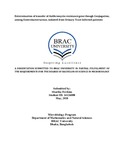Determination of transfer of Azithromycin resistance gene though Conjugation, among Enterobacteriaceae, isolated from Urinary Tract Infected patients

View/Open
Date
2018-05Publisher
BRAC UniveristyAuthor
Ferdous, SharikaMetadata
Show full item recordAbstract
Urinary Tract Infections (UTI) are a predominant bacterial infection caused by pathogens that are resistant to a long list of antibiotics and the greater challenge nowadays is to stop the spread of resistance to them. This study aimed to determine whether resistance to the macrolide—Azithromycin was plasmid mediated and could be transferred via conjugation to the neighboring UTI Enterobacteriaceae. In this study, a total of 28 identified isolates obtained from UTI patients of a Diagnostic Center in Bangladesh were investigated, that contained 22 (78%) organisms from the Enterobacteriaceae family and 6 (21%) organisms from the gram-positive genus. Minimum Inhibitory Concentration (MIC) carried out by the agar dilution method revealed that the Enterobacteriaceae had MIC values of ≥200μg/ml against Azithromycin in 77.3% (17 out of 22) of the organisms and ≥50μg/ml against Ciprofloxacin in 63.3% (14 out of 22) isolates. Plasmid profile showed that 40.9% (9 out of 22) harbored one or more plasmids of sizes ranging from ~2 MDa to ~85 MDa. Based on the antibiotic sensitivity patterns and plasmid profiling, donor and recipient strains were selected for the conjugation experiments carried out in three different methods. In this study, Enterobater spp were selected as donor strains that had high resistance to Azithromycin (MIC: ≥200μg/ml) and contained 2 plasmids (~85 MDa, ~35.6 MDa). On the other hand, plasmid-less, Azithromycin sensitive (MIC: 10μg/ml) Klebsiella spp was selected as a recipient strain for conjugation. Ciprofloxacin was used as a marker to check for the presence of transconjugants. The results revealed that, no transconjugant was observed from the three conjugation assays. Donor strains were then subjected to a plasmid curing procedure with different concentrations of Ethidium Bromide (EtBr) ranging from 1-100μg/ml and 2-20% Sodium Dodecyl Sulfate (SDS). Among the two Enterobacter donor strains used in the study, EtBr successfully cured both plasmids in one strain, whereas the other donor still retained one plasmid after treatment with both reagents. Evaluation of MIC of the cured donors showed the same resistance pattern to Azithromycin (MIC: ≥200μg/ml) proving that the gene responsible for this resistance was not plasmid mediated and hence could not be transferred by conjugation to the recipient Klebsiella. The results of this study indicate that resistance to Azithromycin may not be transferred from Enterobacter species, although this study was only conducted with in-vitro techniques.
